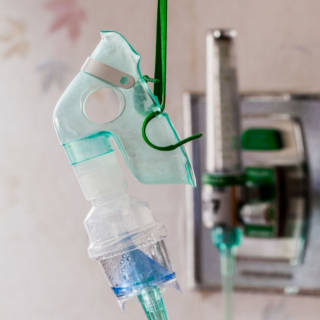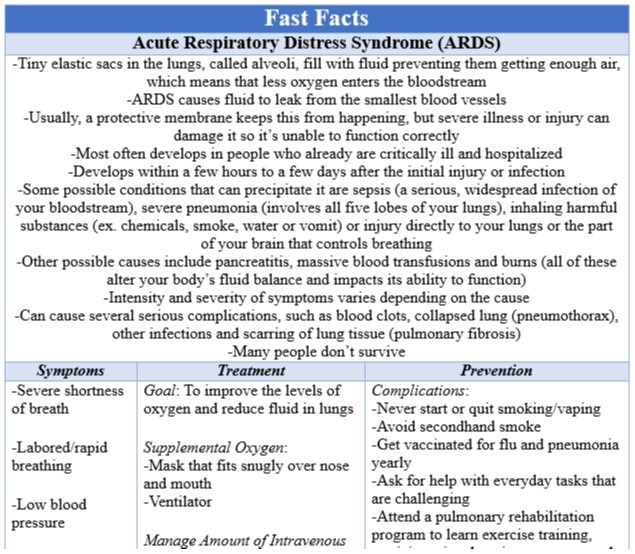What causes it to occur?
Not too long ago in the news, they were talking about a respiratory condition that was referred to as ARDS. ARDS stands for Acute Respiratory Distress Syndrome and is a serious illness. Who is most at risk for developing it? Can it be treated?
 Definition
Definition
The tiny elastic sacs in your lungs are called alveoli. When the alveoli are filled with fluid, it prevents them from filling with enough air, which means that less oxygen enters your bloodstream resulting in less reaching your organs. There are many conditions that can cause fluid to form in your alveoli. In Acute Respiratory Distress Syndrome (ARDS), the fluid is leaked from your smallest blood vessels. Usually, a protective membrane keeps this from happening, but severe illness or injury can damage it so it’s unable to function correctly. This is why ARDS most often develops in people who already are critically ill and hospitalized. It develops within a few hours to a few days after the initial injury or infection. Some possible conditions that can precipitate ARDS are sepsis (a serious, widespread infection of your bloodstream), severe pneumonia (involves all five lobes of your lungs), inhaling harmful substances (ex. chemicals, smoke, water or vomit) or injury directly to your lungs or the part of your brain that controls breathing. Some other possible causes of ARDS include pancreatitis, massive blood transfusions and burns. All of these alter your body’s fluid balance and impacts its ability to function.
The intensity and severity of ARDS symptoms varies depending on the cause. Symptoms include severe shortness of breath, labored/rapid breathing, low blood pressure, confusion and extreme tiredness. ARDS can cause several serious complications, such as blood clots, collapsed lung (pneumothorax), other infections and scarring of lung tissue (pulmonary fibrosis). Due to the severity of the illness and all of the complications that can arise, many people don’t survive. However, with advances that are being made in medicine, more and more people are surviving. Unfortunately, they usually have long term complications, like long-lasting breathing issues, depression, problems with memory/thinking clearing, chronic tiredness and persistent muscle weakness.
Treatment
The first goal of ARDS treatment is to improve the levels of oxygen in your body. This is done with supplemental oxygen. If your symptoms are mild, it’s done via a mask that fits snugly over your nose and mouth and forcing air into your lungs when you breathe in. If your symptoms are severe, you’ll need to be placed on a breathing machine (ventilator). This helps to control how much air is going into your lungs. In either case the purpose is to push some of the fluid out of your alveoli back into the bloodstream, which allows your body to absorb more oxygen. The next important step in treating ARDS is managing the amount of intravenous fluid. This requires a delicate balance because too much fluid can cause more to accumulate in your lungs, but too little fluid puts added strain on your heart and other organs, which can lead to shock. During the course of treatment, you’ll also be given medications to treat primary/prevent secondary infections, relieve pain/discomfort, prevent blood clots, decrease gastric reflux (it can irritate the opening to your lungs and potentially cause stomach fluid to end up in your lungs) and sedate you (if you’re on ventilator).
Once you recover from ARDS, there are several things that you can do at home to help decrease your risk for developing complications. It’s essential that you never start or quit smoking/vaping and avoid secondhand smoke whenever possible. Once you’ve had ARDS you’re more susceptible to contracting the flu or pneumonia, so getting vaccinated yearly is key. Initially, and occasionally after your primary recovery, you might find it challenging to perform certain every day tasks, so it can be beneficial to ask for help from others. Also, attending pulmonary rehabilitation can provide exercise training, education programs and counseling.
Prevention
There isn’t anything specific that you can do to prevent ARDS from developing if you’re critically ill. There are things that you can do to keep your lungs and body healthy, which will decrease your risk of developing ARDS if you do get sick. It’s essential to not smoke or vape because this damages your lungs significantly. Also, maintaining a healthy lifestyle through a well-balanced diet and regular exercise keeps your body healthy and less susceptible to infections. In addition, washing your hands thoroughly and frequently can reduce the number of germs you’re exposed to. Disinfecting surfaces that are known to spread germs is another important consideration. Avoiding activities that have a high risk for injury to your lungs or brain is also good practice.
ARDS is a very serious condition and thanks to improvements in medical treatments is becoming more survivable. If you have any questions or concerns about ARDS, please speak with your doctor. If you would like more information, please visit the American Lung Association’s ARDS page at https://www.lung.org/lung-health-and-diseases/lung-disease-lookup/ards/